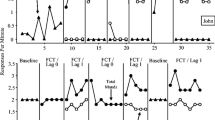Abstract
We assessed acquisition and preference for various mand topographies in the presence of establishing operations that, historically, evoked the aggression of a child with autism. First, we implemented functional communication training (FCT) and reinforced picture exchange, iPad®, or GoTalk® activations in a multi-element format (noting differences in aggression and/or mand independence across conditions). Then, we conducted a concurrent-operant mand preference assessment. Finally, we presented assessment results to the subject’s mother and asked her to indicate her own preference. Parent and subject preferences were aligned and we completed therapy using the iPad®.

Similar content being viewed by others
References
Carr, E. G., & Durand, V. M. (1985). Reducing behavior problems through functional communication training. Journal of Applied Behavior Analysis. doi:10.1901/jaba.1985.18-111.
Fisher, W. W., Kuhn, D. E., & Thompson, R. H. (1998). Establishing discriminative control of responding using functional and alternative reinforcers during functional communication training. Journal of Applied Behavior Analysis. doi:10.1901/jaba.1998.31-543.
Horner, R. H., & Day, H. M. (1991). The effects of response efficiency on functionally equivalent competing behaviors. Journal of Applied Behavior Analysis, 24, 719–732.
Iwata, B. A., Dorsey, M. F., Slifer, K. J., Bauman, K. E., & Richman, G. S. (1994). Toward a functional analysis of self-injury. Journal of Applied Behavior Analysis, 27, 197–209.
Laraway, S., Snycerski, S., Michael, J., & Poling, A. (2003). Motivating operations and terms to describe them: some further refinements. Journal of Applied Behavior Analysis. doi:10.1901/jaba.2003.36-407.
Ringdahl, J. E., Falcomata, T. S., Christensen, T. J., Bass-Ringdahl, S. M., Lentz, A., Dutt, A., & Scuh-Claus, J. (2009). Evaluation of a pre-treatment assessment method to select mand topographies for functional communication training. Research in Developmental Disabilities. doi:10.1016/j.ridd.2008.06.002.
Touchette, P. E., & Howard, J. S. (1984). Errorless learning: reinforcement contingencies and stimulus control transfer in delayed prompting. Journal of Applied Behavior Analysis. doi:10.1901/jaba.1984.17-175.
Winborn, L., Wacker, D. P., Richman, D. M., Asmus, J., & Geier, D. (2002). Assessment of mand selection for functional communication training packages. Journal of Applied Behavior Analysis. doi:10.1901/jaba.2002.35-295.
Winborn-Kemmerer, L., Ringdahl, J. E., Wacker, D. P., & Kitsukawa, K. (2009). Demonstration of individual preference for novel mands during functional communication training. Journal of Applied Behavior Analysis. doi:10.1901/jaba.2009.42-185.
Winborn-Kemmerer, L., Wacker, D. P., Harding, J., Boelter, E., Berg, W., & Lee, J. (2010). Analysis of mand selection across different stimulus conditions. Education and Treatment of Children. doi:10.1353/etc.0.0086.
Acknowledgments
We thank Lindsay Clark and Carrie Glover who assisted in conducting this study, S. Shanun Kunnavatana and Casey Clay who aided in its conceptualization, and the Treatment and Research Institute for Autism Spectrum Disorders (TRIAD) for providing access to clinical rooms used in this study.
Compliance with Ethical Standards
This manuscript is not published (or under review) elsewhere and was approved by all authors and responsible authorities where the work was carried out. We obtained informed consent before initiating study-related activities.
Author information
Authors and Affiliations
Corresponding author
Additional information
Implications for Practitioners
• It is possible to assess the mand-topography preferences of individuals with limited verbal repertoires.
• Incorporating a learner’s preferred mand topography into FCT may increase treatment efficacy.
• Mand-topography acquisition and preference assessments can be embedded into FCT.
• Response effort may influence a learner’s mand-topography preference.
Rights and permissions
About this article
Cite this article
Torelli, J.N., Lambert, J.M., Da Fonte, M.A. et al. Assessing Acquisition of and Preference for Mand Topographies During Functional Communication Training. Behav Analysis Practice 9, 165–168 (2016). https://doi.org/10.1007/s40617-015-0083-y
Revised:
Published:
Issue Date:
DOI: https://doi.org/10.1007/s40617-015-0083-y




